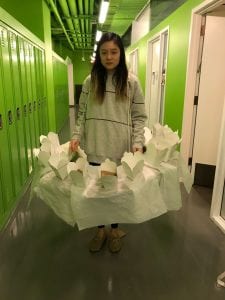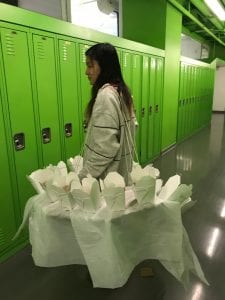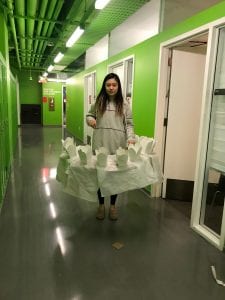Final Picture:
The Poem: Peaches
A crate of peaches straight from the farm
has to be maintained, or eaten in days.
Obvious, but in my family, they went so fast,
I never saw the mess that punishes delay.
I thought everyone bought fruit by the crate,
stored it in the coolest part of the house,
then devoured it before any could rot.
I’m from the Peach State, and to those
who ask But where are you from originally,
I’d like to reply to The homeland of the peach,
but I’m too nice, and they might not look it up.
In truth, the reason we bought so much
did have to do with being Chinese—at least
Chinese in that part of America, both strangers
and natives on a lonely, beautiful street
where food came in stackable containers
and fussy bags, unless you bothered to drive
to the source, where the same money landed
a bushel of fruit, a twenty-pound sack of rice.
You had to drive anyway, each house surrounded
by land enough to grow your own, if lawns
hadn’t been required. At home, I loved to stare
into the extra freezer, reviewing mountains
of foil-wrapped meats, cakes, juice concentrate,
mysterious packets brought by house guests
from New York Chinatown, to be transformed
by heat, force, and my mother’s patient effort,
enough to keep us fed through flood or storm,
provided the power stayed on, or fire and ice
could be procured, which would be labor-intensive,
but so was everything else my parents did.
Their lives were labor, they kept this from the kids,
who grew up to confuse work with pleasure,
to become typical immigrants’ children,
taller than their parents and unaware of hunger
except when asked the odd, perplexing question.
The intention of the Home project was to create a wearable, functional garment that relates to home, and also inspired by the poem “Peaches”. I wanted my garment to express what home means to me through classic Chinese cuisines, and in order to do so, I created a wearable Chinese restaurant table, because for me, at a dinner table is where home is reminded for me with my family and friends gathered around the restaurant table, eating, laughing and talking. In order to create my restaurant table garment, I gathered the supplies of cardboard, big plastic bags, Chinese takeout boxes, Chinese crackers, strings, and some hot glue. The cardboard is used to create the round shaped lazy Suzy table, as I will be slowly spinning in my performance. The big plastic bags are functioned as in real Chinese restaurants, they would put multiple layers of plastic over the table so it would be easier to clean up the customer’s mess, and I wanted to replicate that authentic feel. The Chinese takeout boxes are used as the “dishes” on the table, as I feel like the message would go through stronger if I use Chinese takeout boxes rather than plates so that the audience would know its Chinese food, and that’s what it means home to me. I chose to put Chinese crackers into the boxes rather than other kinds of food like rice, because when my family starts dinner, we would always open a bag of Chinese crackers and pour it in a bowl as an appetizer, and I realize that everytime I snack on those crackers, it would take me back to home. The strings are what is going to make this restaurant table garment wearable and functional.
In the beginning, professor Andrea gave the class an assignment to find a poem that relates to me personally what home is, and I picked the poem “Peaches” because the poem speaks out about growing up as a child of an immigrant family, and where food is being played as an element of home in the poem. Personally, I grew up in an immigrant family, and then I relate to the poem “Peaches”, as it explains that the family don’t have a lot of money and the parents would never show the bad side to their child, and no matter what, they will never let their child go hungry. Then, the next class I had to start brainstorming about ideas of what I was going to do, and as I presented my poem to professor Andrea and she recommended me to go to the MOCA, and at first I wanted to make a dress out of Chinese takeout boxes and plastic bags, and put fortune cookies in them for the audience to take, but I wanted to do something more about food rather than just putting a lot of attention to plastic bags and Chinese takeout boxes. When I went to MOCA and saw a dinner table filled with Chinese cuisines, it inspired me to make do a garment of the restaurant table as a functional garment. First, I gathered the supplies and used cardboard to make a round shaped table with a hole in the middle for me to go in. Next, I put the big plastic bags around the table to create that authentic chinses restaurant feeling, and I glued the Chinese takeout boxes to the table and filling them up with the Chinese crackers. To make the garment functional and wearable, I strapped strings to 4 sides of the table and it would strap onto my shoulder so the table would be up to my waist.
Process Picture:
The only part that was difficult in the process was to cover the cardboard box with the plastic bags in a way that it didn’t look trashy or unprofessional. The trash bags would bunch up a lot of the times and not stay in the place it was supposed to, and having to fix the bags was the most difficult part of this project, and to solve that, I just glues the whole cardboard box to the plastic bags so it would not move around as much, and I ended up tucking the inner circle with tape so the bags would not fall.
Through this project, I have grown in a lot of ways, as I used all the lessons and abilities that I have learned throughout the course to make this project as an artist. I have learned how to make wearable garments not look trashy, and my performance ability improved as I practiced my choreography. I not only had growth as an artist but also as a person, learning about how to connect things and meanings to where a project would perform at its peak.




